Beaded Chainmaille Tutorial – Beaded Chainmaille Bracelet
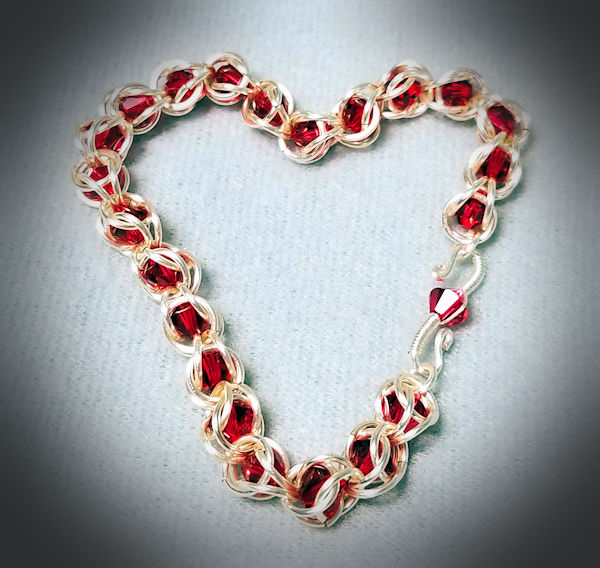
Beaded Chainmaille Bracelet
A beaded chainmaille tutorial you ask? Well, you did ask, so here’s the first of my projects! The beaded chainmaille bracelet jewelry video tutorial is below, but before we get there, let’s talk about jump rings a bit more first.
Jump Rings 101 (Short Version)
I do have a more in-depth post and free PDF about jump rings, but let’s do a quick overview, so you can make sure you have the right rings for the project.
The two most important items are wire gauge (how thick the wire is) and the inside diameter (ID) of the rings. I tend to use 18 gauge wire most often, for the following reasons:
- It’s sturdy enough to not warp easily.
- It has a thickness of 1mm. (Ok, it’s officially 1.02mm, but close enough.)
That means that if the rings I am buying has the size listed as outside diameter (OD), all I have to do is subtract 2mm from that to get the ID. That makes it easy to know the aspect ratio (AR) of the rings — and for that I will have you see the above link for the nitty-gritty details. 😀
Jump Ring Sizes for the Beaded Chain Maille Tutorial
For the project, you will need 18 gauge jump rings that have an ID of 6mm. You can go as low as 5.9 or as high as 6.5, but 6mm is the “sweet spot”. You’ll also need some smaller rings for the ends — I think the ones I used were around 4mm, but you could use 3.5mm if that’s all you have. And if you only have the 6mm rings, you can use those as well! I just happen to like smaller rings for the ends.
Beads for the Project
For the beads, I highly suggest you use 6mm bicones. The reason is that the bicone shape lets the beads “snuggle down” and lets the top rings close easily. While you can use fire-polished or round beads, I don’t suggest you use them for this particular project — they make it very difficult to get the top rings closed.
(I will shortly have another beaded chainmaille jewelry tutorial that can use fire-polished or round beads – I’ll put the link here as soon as it’s done.)
Clasp — What to Choose?
The clasp is whatever you want to use. I made an S clasp, one that uses the same bead as in the bracelet. There is nothing stopping you from using anything else, though. If you want some ideas for making your own clasp, check out my clasp-making tutorial post.
Ready, Set — Here’s the Video!
Without further ado, here’s the video for the beaded chain maille jewelry tutorial — I hope you enjoy it!
Half Persian 3-in-1, 4-in-1 and DragonBack Tutorial
The chain maille HP (Half Persian) weaves are intriguing and DragonBack is exciting! Well, at least that’s my opinion. How a person can take the small rings and make such a densely-woven piece of jewelry was amazing to me. Welcome to the HP world!
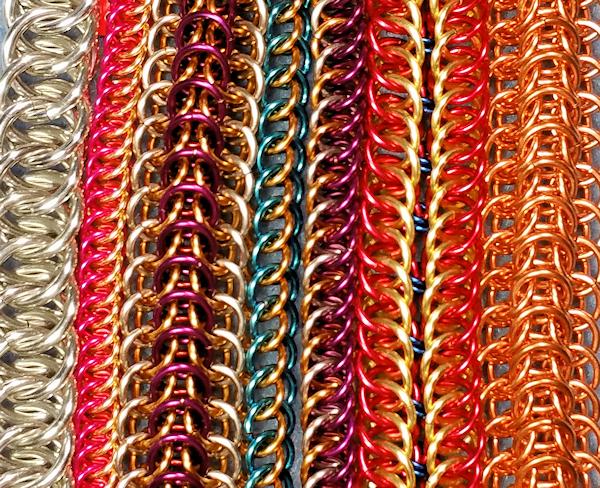
Half Persian 3in1, 4in1 and DragonBack Tutorial
I know that HP has the reputation of being difficult, but it really isn’t — at least not without a little help in the very beginning (which of course I provide). Then like most weaves, once you have the rhythm, it’s not all that hard at all! There are lots of very detailed photos to show you what ring goes where.
(Note to anyone reading this post on Google Translate — this ebook is written in English.)
What’s in the Tutorial?
We’ll start out with the easiest of the weaves — the HP3in1. With a couple of tips in the very beginning on how to start the weave, it becomes a whole lot easier!
Once you have the hang of that weave, time to move onto the HP 4in1. This is a beautiful, very dense weave. Once again I provide two different ways to start out the weave to make things that much easier!
Do you want to double your fun? How about a doubled HP 4in1! It’s actually pretty easy, and it’s reversible in a way that can give you two different looks.
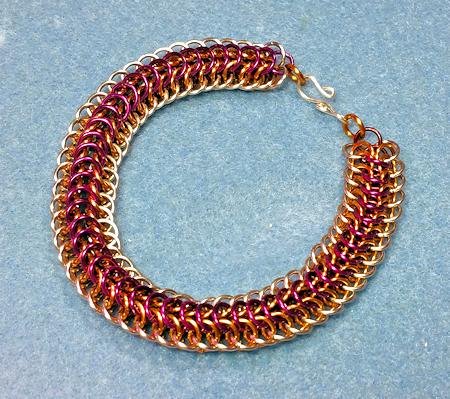
              DragonBack Bracelet
We’ll finish up with DragonBack, which is a weave that is rather unusual and not often seen. It, too, is a dense weave, and it makes a very substantial piece of jewelry. Not to mention an absolutely gorgeous one! But please note — DragonBack and the more commonly-seen DragonScale are not the same weave. In this ebook I teach you DragonBack.
With these weaves, I demonstrate each weave in at least two different color rings, so you can more easily see how the weave is put together. I also show some common mistakes, how to recognize them quickly and how to fix them.
There’s lots in the ebook. It’s 37 pages and has 79 photos, so you have a lot of instructions and plenty of close-ups. The photo at the top of the page shows all the weaves you’ll find in this ebook tutorial. This ebook is in PDF form, and is just a little over 1.6 MB in size.
Purchase the Tutorial
The ebook is just $6, which is a small amount for everything you get, especially with the super-close-up photos — which many times I show multiple angles so you are sure where to put that next ring!
You can buy the ebook securely through the link below. All major credit cards are accepted. Just as an FYI, it does go through the PayPal interface. You will get a link for an immediate download — and then you’re on your way!
Thanks so much for reading this far, and happy maille-ing!
Get Wired Up! Wrapping, Knitting, Weaving and More
I’ve enjoyed working with wire for many years — in fact, it’s what drew me into making jewelry in the first place! I started with wire work (also known as wire wrapping), then moved onto chain maille, then viking knit, wire crochet and now wire weaving.
So which is my favorite? Hard to choose for sure! In fact, I don’t know that I can choose a favorite, other than to say whichever I feel like working on is my favorite, LOL.
Wrapping Versus Weaving – Is There a Difference?
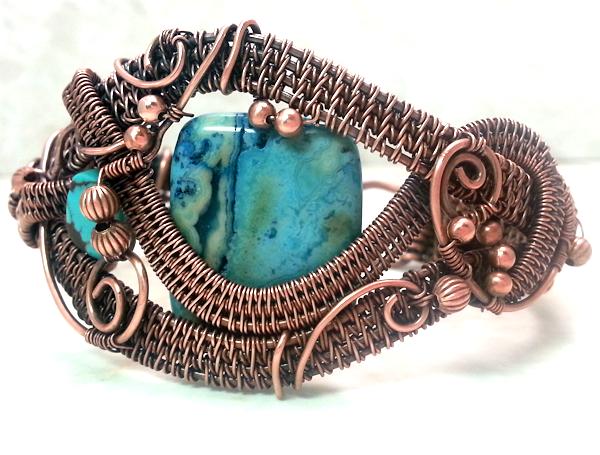
This was actually the very first wire weaving bracelet I ever made. Turned out much better than I had expected. 😀
Some people say there is no difference — that both are just manipulating wire into different shapes. Me, I think there is a difference. When I started with the wire wrapping, it was all about wrapping it around an object. Wire wasn’t made into shapes for the sake of the wire, but to capture something.
Wire weaving, on the other hand, features the wire. There may be a bead or cabochon involved, like in the photo to the right, the real star of the show is the weaving.
There are plenty of patterns for the weaving, involving from two to a zillion base wires. OK, maybe not a zillion, but the bracelet in the photo ended up using 8 base wires in places.
If you’re interested more in manipulating wire, here’s my Youtube playlist on wirework of all kinds.
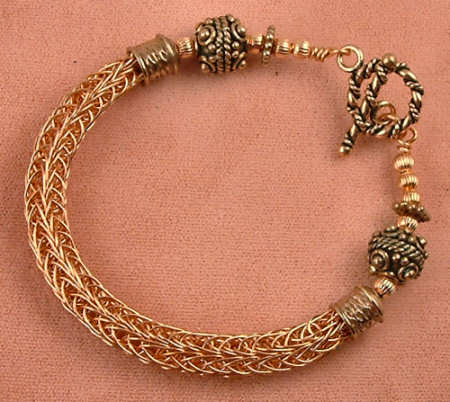 Viking Knit
Viking Knit
I did (and still do) find viking knit very intriguing. I can’t knit a darned thing with yarn, but I discovered that wire was much easier – for me, at any rate.
Most of the time, viking knit is the means and the end — the wire is very definitely the star. There may be beads incorporated into the jewelry like in the photo to the left, but the emphasis is on the wire knitting.
And similar to wire weaving, there are different patterns that one can use to create jewelry. Single knit and double knit are the most popular, though.
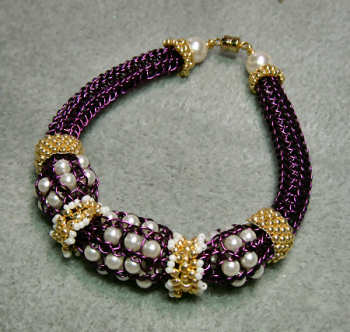
Viking Knit Jewelry Embellishments
But…if you are interested in something a with a little more integrated, you can do more. How much more? Take a look at the image on the right.
In this bracelet, the viking knit shares the stage with beads. Not just pearls, but also seed beads.
In addition to single knit and double knit, triple knit is also an option. It does make the chain stiffer, but it is quite dense and lovely.
There is also a layered knit which is kind of cool.
If you’d like more info on some more advanced viking knit, check out my ebook tutorial.
Wire Crochet
This is something I’ve only really dabbled in. I like the freedom it provides — the technique is quite organic in nature. Up to now, I’ve primarily worked with varying the size of the stitches within the project and adding random beads. I think my next challenge will be to regulate the size of the stitches and use the same beads within the project. If I can get it worked out, I’ll set up a video for it.
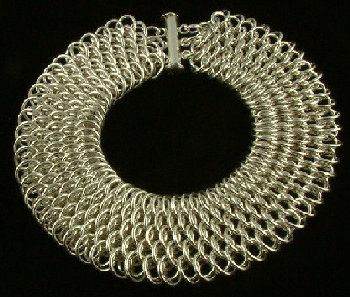
Dragonscale Bracelet, Sterling Silver
Chain Maille
Oh, I’ve got lots of posts on chain maille, and even a second site devoted to it — chainmaillejewelrypatterns.com. I get a kick out of chain maille, and it makes for some gorgeous jewelry.
When I started out with chain maille, sterling silver jump rings were relatively inexpensive — silver was around $7/ounce. I got lots and lots of rings, in all kinds of sizes and gauges. And I set my fingers to maille-ing.
The photo to the left is a pattern called “Dragonscale”. The weave is quite dense, and this particular bracelet was made with sterling silver — talk about substantial! I did sell it and I kind of wish I hadn’t, seeing as I’ve not made another such bracelet again. Well, I take that back…I started another one, but with copper wire, and I haven’t finished it.
I’m also getting ready to publish another ebook for HP 3-in-1 and HP 4-in-one. And in that ebook, I have a pattern called “Dragonback”. That weave is also pretty substantial, but this time I did it in copper. (Once I have it finished, I’ll put a link here.)
Getting Started With Wire
If you’re interested in starting to work with wire, here’s what I would recommend. And the first would be to use copper wire — it’s inexpensive and soft on the hands. Well, maybe “soft” isn’t quite the right term, but it’s much easier to manipulate than brass, bronze or sterling.
I’d recommend a few different wire gauges to start — 18, 20, 22, 26 and 28 are good choices. The 26 and 28 gauges are great for viking knit and crochet. Most of the wire weaving I do are in gauges 22, 26 and 28. However, the heavier gauges are better for parts of the project that are more load-bearing.
Chain maille — again, I suggest copper as your introduction. And I will refer you to my free guide for chain maille rings for a more in-depth discussion for what you should look for in your rings. It will help you to understand things like AR, ID and OD which are very important to your project success.
I hope this post has been helpful, and that you enjoy your journey into working with wire!

